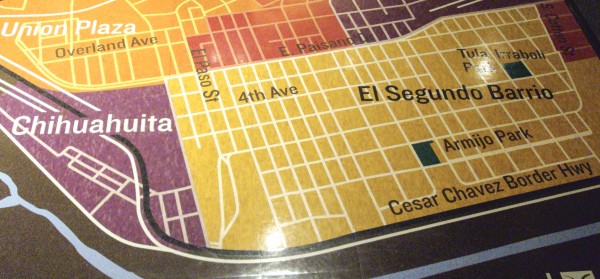
One of the many murals that give its personality to Segundo Barrio can be found at E. Father Rahm Ave. (Azenett Cornejo/Borderzine.com)
EL PASO — Walking through a dark hall and swinging open the pair of steel gates, museum guests are thrown into a room with walls exquisitely decorated with the memories of this city’s most history-rich neighborhoods.
Bright and colorful murals at the El Paso History Museum exhibit surround the viewer with quotes and representations of two of El Paso’s first neighborhoods.
Neighborhoods and Shared Memories is an exhibit that shows what life was like in the Segundo Barrio and Chihuahuita neighborhoods as children grew up in the area.
El Paso’s oldest neighborhoods continue to thrive in the southern part of the city with an extensive history as a place of refuge and social and economic struggle. Today, vivid murals on aged structures along the two-way streets give an insight into the cultural influences once existed.
“We wanted to reach out to all the folks who had not had a voice, who were not represented in the history. The original exhibit plans for this building was that this gallery was designated from the begining to be the headquarters for the neighborhoods exhibit” says senior curator Barbara Angus.
“The concept was that even from the beginning the exhibits that were created were directly by the people from the neighborhoods,” said Angus.

Each wall represents one neighborhood with phrases from people who lived in the area and their memories of life there. To the right, El Segundo Barrio and to left Chihuahuita both represented by oral histories.
In the middle, computers are set up with archived photographs, more oral histories, and through them visitors can leave an email to request more information. Next to the computers kids can recreate the city with rubber building blocks.
In a room with theater seating, an 11-minute video plays showing different histories of the apartments, housing, chores, downtown areas, and oral reflections of the neighborhoods.
The back wall has a stack of post-its for people to share their own memories about either neighborhood. They can post thoughts or questions they want answered by the local community.
Several decades are displayed from the 1920’s all the way up to the present.
While many residents expressed a warm sentiment for the neighborhoods, they had some of the worst housing conditions in the country. Although the city gradually made improvements to the neighborhoods, the neighborhoods today still exhibit the rough-edged buildings and project housing that people live in. Bars still cover the windows of many apartment complexes and the economic woe of its residents is evident.
“We decided that we would go to each El Paso neighborhood and reach out to community members, obtain oral histories in conjunction with the oral history department at UTEP, ask for permission to scan photographs and borrow items for the length of the exhibit,” said Angus.
Jesus “Cimi” Alvarado, who grew up in Segundo Barrio, painted the murals in the exhibit.
“Over the next two years, the exhibit will feature a new set of neighborhoods. The neighborhoods exhibit seeks to preserve, interpret, and increase an appreciation for neighborhood-based history” says the El Paso History Museum website.
Both neighborhoods have been an integral part of El Paso’s Mexican culture for decades. Despite their rough exterior and increasingly transient population, many continue to call them home.
